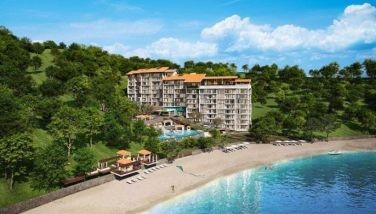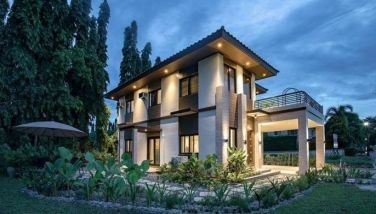Nueva Ecija farmers soon proud homeowners
October 22, 2001 | 12:00am
CABANATUAN CITY – Local farmers may soon find themselves as proud owners of dream houses they can truly call their own in Nueva Ecija.
The dream house which could be a concrete single-story, two-bedroom, structure with a living room may soon become a reality under a P1-billion low-cost housing program for local farmers dubbed Pabahay sa Magsasaka (Housing for Farmers) Program of Nueva Ecija launched recently by the provincial government and other government agencies.
The program, a brainchild of Gov. Tomas Joson III, aims to provide financing for construction of housing units for credit-worthy and qualified farmers who will be given access to funds to build his dream house in his own lot.
Also involved in the program are the various local government units (LGUs), the Department of Agrarian Reform (DAR), Home Mortgage Development Fund (HMDF) or Pag-ibig, the National Housing Authority (NHA), the contractor/developer and conduit bank.
Under the program, the provincial government is tasked to prepare the capsule project concept and submit it to the HMDF, conduct the profiling, screening and facilitation of prospective beneficiaries, promotion of the program, availment of P10 million revolving fund from the LGU Pabahay program, guarantee the housing loan.
The HMDF is tasked to set up funds for the program, help formulate viable housing package for farmers and implement guidelines.
Beneficiaries of the program are local farmers belonging to the Cluster 1000 Agricultural Development Program (CADP) of the provincial government or any affiliated or parallel agricultural development program in other municipalities in the province.
Under the scheme drawn up by the provincial government, the beneficiary farmer, to qualify must own a 500-square meter home lot, titled and free from any encumbrance, must own at least two hectares of productive agricultural land which have access to year-round irrigation, must not be above 50 years of age and in good health, must have good credit standing and eligible to obtain health and mortgage insurance.
A CADP member will avail of several benefits such as credit access to certified seeds, training and new technology, fertilizers, pest control and management, post harvest facilities, crop insurance, Philhealth insurance among others.
A CADP member’s palay output can also be taken to the provincial government’s grains center to maximize his output which will later be purchased by the National Food Authority (NFA) through its buying station located in the center.
San Isidro Mayor Sonia Lorenzo said that among the pilot areas of the program, which is aligned with the housing program of President Arroyo, is her town based on a specific case study of its "San Isidro Pamana 2004 on Agricultural Development." Under this own scheme, Pamana 2004 farmers must be certified seed grower or seed user, must undergo a season-long training in the farmer field house under the Ginintuang Ani (GA) program of the Department of Agriculture (DA) on integrated pest management (IPM).
At least 200 housing units are being eyed in the town to jump-start the project in its nine barangays of Poblacion, Alua, Malapit, Sto. Cristo, San Roque, Calaba, Pulo, Tabon and Mangga.
Under San Isidro’s own project concept, it was noted that existing government housing program cater to various sectors but none for the farmers in Nueva Ecija where 70 to 75 percent of the population depends on agriculture for livelihood. It noted that a great number of these farm families stay in pathetic dwelling units made of ragtag materials which barely serves the function of shelter in the real sense.
Lorenzo stressed that the municipal government provides farm credit support to farmers worth P8,000 for the purchase of inputs such as fertilizers and certified seeds. It also advances premium payments for farmers who thus avail of crop insurance provided by the Philippine Crop Insurance Corp. (PCIC).
Additionally, Lorenzo said that farmer beneficiaries of the program will also have access to the San Isidro Anti Poverty Program (SIAPP), a livelihood assistance that will enhance the income of farmers through provision of livestock, vegetable seeds, herbal plant cultivation and tilapia seedlings for the backyard pond as well as micro-financing facility such as basket-weaving, mushroom culture and local food processing.
Lorenzo said a farmer-beneficiary must have a net income from rice cultivation and from livelihood of P99,000 for two croppings.
The envisioned dream house, Lorenzo explained, is a concrete single story structure measuring 39 square meters. It will have two bedrooms, one toilet bath, a living room and dining room. The average cost of construction of the house is P180,000.
The loan to be availed of by the farmer will carry 25-year amortization at interest of 9 percent interest per annum paid on a quarterly basis at P1,000 per month for the first five years.
Lorenzo said that the collateral for the housing loan will be the titled 500-square meter lot of the farmer who will also be required to secure a health insurance.
The dream house which could be a concrete single-story, two-bedroom, structure with a living room may soon become a reality under a P1-billion low-cost housing program for local farmers dubbed Pabahay sa Magsasaka (Housing for Farmers) Program of Nueva Ecija launched recently by the provincial government and other government agencies.
The program, a brainchild of Gov. Tomas Joson III, aims to provide financing for construction of housing units for credit-worthy and qualified farmers who will be given access to funds to build his dream house in his own lot.
Also involved in the program are the various local government units (LGUs), the Department of Agrarian Reform (DAR), Home Mortgage Development Fund (HMDF) or Pag-ibig, the National Housing Authority (NHA), the contractor/developer and conduit bank.
Under the program, the provincial government is tasked to prepare the capsule project concept and submit it to the HMDF, conduct the profiling, screening and facilitation of prospective beneficiaries, promotion of the program, availment of P10 million revolving fund from the LGU Pabahay program, guarantee the housing loan.
The HMDF is tasked to set up funds for the program, help formulate viable housing package for farmers and implement guidelines.
Beneficiaries of the program are local farmers belonging to the Cluster 1000 Agricultural Development Program (CADP) of the provincial government or any affiliated or parallel agricultural development program in other municipalities in the province.
Under the scheme drawn up by the provincial government, the beneficiary farmer, to qualify must own a 500-square meter home lot, titled and free from any encumbrance, must own at least two hectares of productive agricultural land which have access to year-round irrigation, must not be above 50 years of age and in good health, must have good credit standing and eligible to obtain health and mortgage insurance.
A CADP member will avail of several benefits such as credit access to certified seeds, training and new technology, fertilizers, pest control and management, post harvest facilities, crop insurance, Philhealth insurance among others.
A CADP member’s palay output can also be taken to the provincial government’s grains center to maximize his output which will later be purchased by the National Food Authority (NFA) through its buying station located in the center.
San Isidro Mayor Sonia Lorenzo said that among the pilot areas of the program, which is aligned with the housing program of President Arroyo, is her town based on a specific case study of its "San Isidro Pamana 2004 on Agricultural Development." Under this own scheme, Pamana 2004 farmers must be certified seed grower or seed user, must undergo a season-long training in the farmer field house under the Ginintuang Ani (GA) program of the Department of Agriculture (DA) on integrated pest management (IPM).
At least 200 housing units are being eyed in the town to jump-start the project in its nine barangays of Poblacion, Alua, Malapit, Sto. Cristo, San Roque, Calaba, Pulo, Tabon and Mangga.
Under San Isidro’s own project concept, it was noted that existing government housing program cater to various sectors but none for the farmers in Nueva Ecija where 70 to 75 percent of the population depends on agriculture for livelihood. It noted that a great number of these farm families stay in pathetic dwelling units made of ragtag materials which barely serves the function of shelter in the real sense.
Lorenzo stressed that the municipal government provides farm credit support to farmers worth P8,000 for the purchase of inputs such as fertilizers and certified seeds. It also advances premium payments for farmers who thus avail of crop insurance provided by the Philippine Crop Insurance Corp. (PCIC).
Additionally, Lorenzo said that farmer beneficiaries of the program will also have access to the San Isidro Anti Poverty Program (SIAPP), a livelihood assistance that will enhance the income of farmers through provision of livestock, vegetable seeds, herbal plant cultivation and tilapia seedlings for the backyard pond as well as micro-financing facility such as basket-weaving, mushroom culture and local food processing.
Lorenzo said a farmer-beneficiary must have a net income from rice cultivation and from livelihood of P99,000 for two croppings.
The envisioned dream house, Lorenzo explained, is a concrete single story structure measuring 39 square meters. It will have two bedrooms, one toilet bath, a living room and dining room. The average cost of construction of the house is P180,000.
The loan to be availed of by the farmer will carry 25-year amortization at interest of 9 percent interest per annum paid on a quarterly basis at P1,000 per month for the first five years.
Lorenzo said that the collateral for the housing loan will be the titled 500-square meter lot of the farmer who will also be required to secure a health insurance.
BrandSpace Articles
<
>
- Latest
Latest
Latest
October 11, 2024 - 3:45pm
October 11, 2024 - 3:45pm
October 10, 2024 - 11:30am
October 10, 2024 - 11:30am
October 5, 2024 - 12:08pm
October 5, 2024 - 12:08pm
September 24, 2024 - 1:00pm
September 24, 2024 - 1:00pm
September 13, 2024 - 4:00pm
September 13, 2024 - 4:00pm
September 9, 2024 - 9:45am
September 9, 2024 - 9:45am
Recommended





























